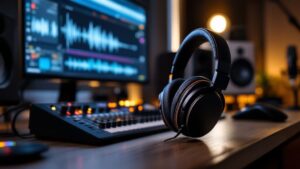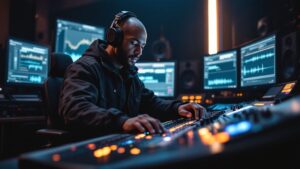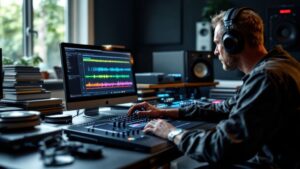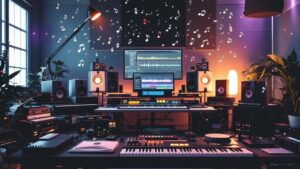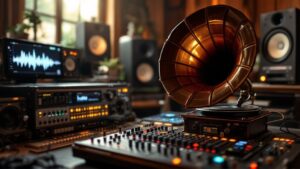The Evolution of Music Production Technology
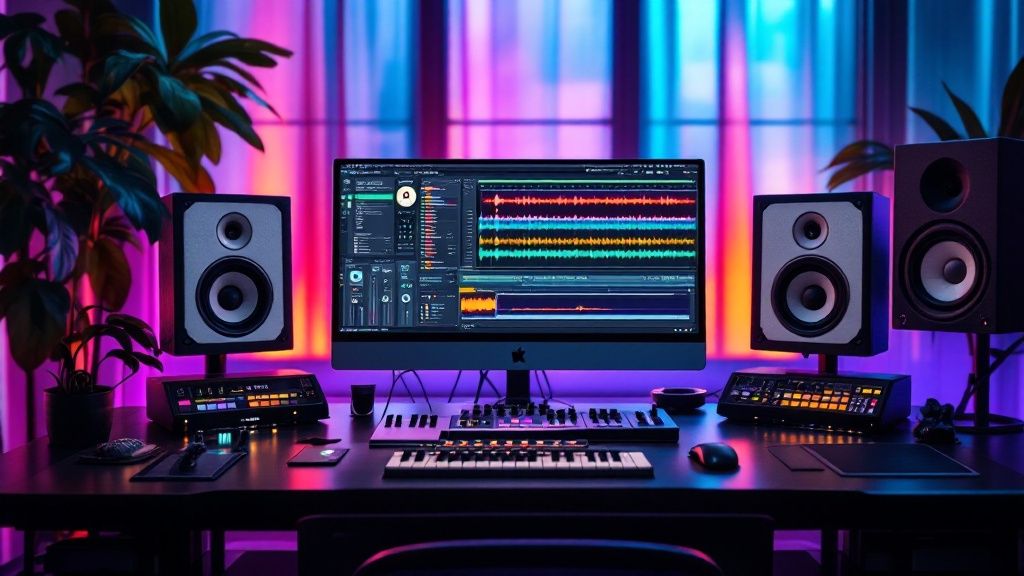
Music production has grown from simple recording devices into a rich blend of art and technology. The tools we use to create and capture music have changed dramatically – from basic recording equipment to modern digital audio workstations (DAWs). This growth has created its own special language of music production terms that producers need to know. Looking at this history helps us understand how we make music today.
It all began in 1877 when Thomas Edison invented the phonograph. This first-of-its-kind device used two tin foil-wrapped cylinders and a needle to both record and play back sound. Later, Emile Berliner created the gramophone in the late 1800s, switching from cylinders to discs for better sound quality and longer-lasting recordings. Many terms we still use today come from these early innovations. Learn more about the history of music recording.
From Analog to Digital: A Seismic Shift
The analog recording era brought major changes in the 20th century. The introduction of magnetic tape made multi-track recording possible, completely changing how music was arranged and produced. This period gave us important terms like overdubbing, tape splicing, and mixing consoles. The concept of gain staging, which remains crucial today, came from working with analog equipment's specific traits and limits.
The Digital Revolution: DAWs and Beyond
When digital audio workstations (DAWs) arrived in the late 20th century, they changed everything about making music. Moving from analog tape to digital recording brought new terms into common use – quantization, MIDI, plugins, and virtual instruments. These digital tools made music production available to many more people than ever before.
The Impact of Technology on Music Production Terminologies
As music technology has grown, so has the language we use to talk about it. New tools and techniques need new words to describe them. This means producers must keep learning new terms to stay current. Understanding how older concepts connect to modern methods helps producers work more effectively with today's music production tools.
Essential Recording Equipment Terminology Decoded
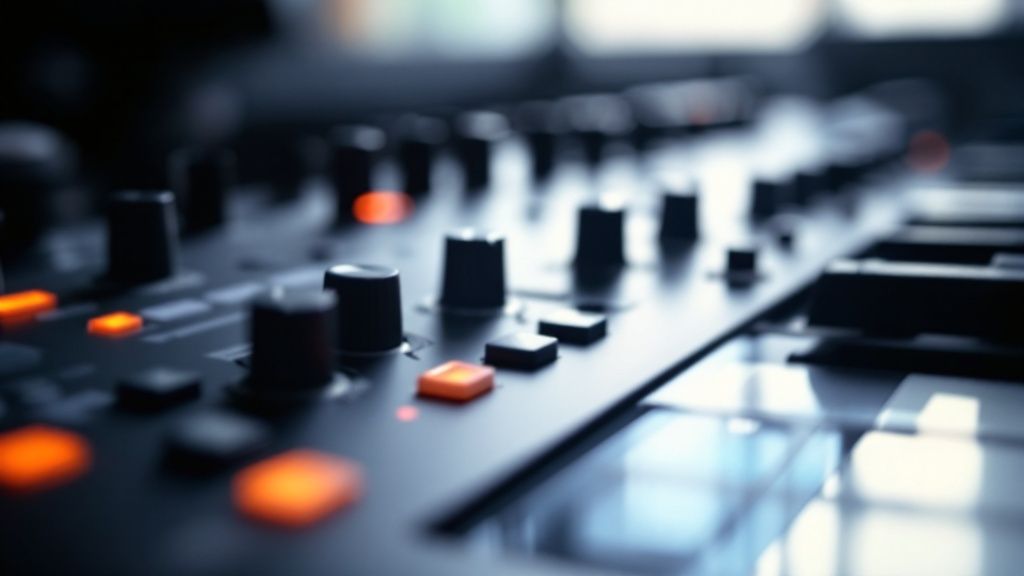
Getting familiar with recording equipment terms is key for anyone starting out in music production. This knowledge helps you make better decisions about gear, fix problems quickly, and capture higher quality sound. Let's break down some of the most important terms you'll encounter.
Gain Staging: The Foundation of a Clean Signal
Gain staging is how you manage audio levels as your signal moves through the recording chain. Think of it like setting volume levels at multiple points – from your mic to your interface to your DAW. When done right, gain staging gives you a clean, noise-free signal that's ready for mixing.
Impedance Matching: Keeping the Signal Flowing Smoothly
Impedance (measured in ohms) shows how much a device resists the flow of AC current. Impedance matching means connecting devices with compatible input and output levels. For instance, pairing a low-impedance mic with a high-impedance preamp ensures the best signal transfer. Poor impedance matching can cause signal loss or unwanted changes to your sound.
Signal Flow: Tracing the Audio Journey
Signal flow maps out how audio travels from start to finish in your setup. It's like following the path from your mic through various processors and finally into your computer. Understanding this flow helps you control your sound and quickly spot any issues in the chain.
Microphones: Capturing the Source
Your choice of mic greatly affects your recorded sound. Each type has its strengths – dynamic mics handle loud sounds well, making them perfect for drums, while condenser mics capture more detail, ideal for vocals and acoustic instruments. Ribbon mics offer their own unique character. Mic technology has come a long way since the early 1900s when the first models changed how we capture and share music. Learn more about music production history.
Preamps: Boosting the Signal
Preamps take the weak signal from your mic and boost it to a usable level. Each preamp adds its own flavor to your sound – some add warmth and character, while others aim for a clean, accurate boost. Your choice of preamp can significantly shape your final sound.
Analog-to-Digital Converters (ADCs): Bridging the Gap Between Analog and Digital
ADCs turn your analog audio into digital information that your computer can process. The quality of this conversion depends on two factors: bit depth and sample rate. Higher values in both mean a more accurate digital copy of your analog signal. This digital conversion opened up endless possibilities for editing and processing sound.
By mastering these basic recording concepts, you'll be better equipped to capture great sound. This knowledge helps you choose the right gear and use it effectively to get the results you want. Plus, you'll save time troubleshooting when things don't sound quite right.
Mastering Digital Audio Workstation (DAW) Language
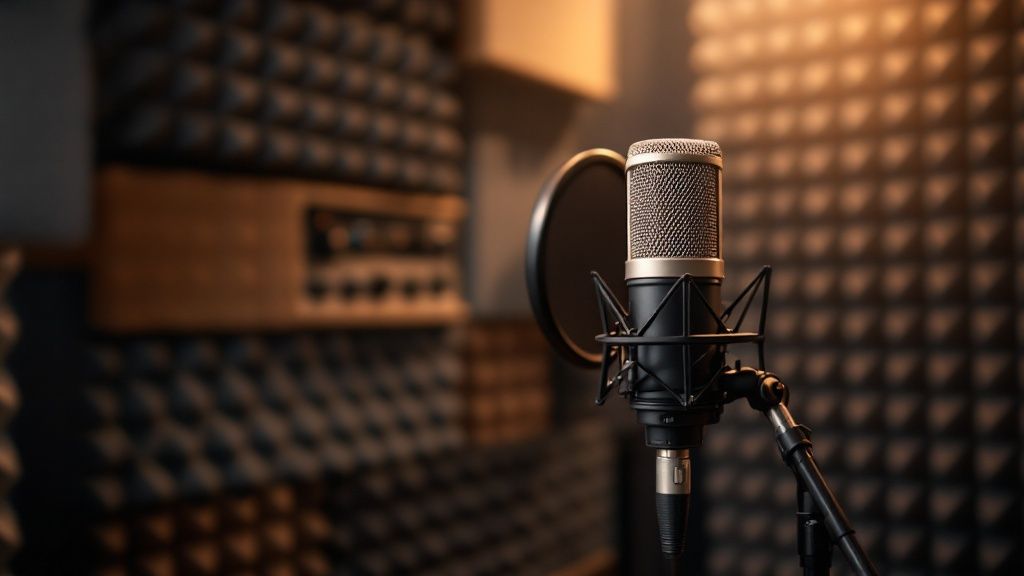
Modern music production centers around Digital Audio Workstations (DAWs). To work effectively with these tools, you need to understand their key terms and functions. Let's explore the essential DAW concepts that will help you bring your musical ideas to life.
Key DAW Concepts for Better Workflow
A DAW is your central hub for recording, editing, and arranging music. While these programs pack many features, focusing on these core concepts will help you get started:
-
Session Management: Good organization of your project files, tracks, and plugins makes everything run smoother. Simple tricks like color-coding tracks and using clear names help you find what you need quickly.
-
Key Commands: Learning keyboard shortcuts saves tons of time. Instead of clicking through menus, you can instantly do common tasks like copy, paste, and zoom. Taking time to learn these commands pays off in faster workflow.
-
Automation: This lets you program changes to settings like volume, panning, and effects over time. For example, you could make a vocal gradually get louder or create filter effects that sweep through your track.
Going Deeper with Advanced Features
Once you've got the basics down, these more advanced concepts open up new creative possibilities:
-
Mixing Workflows: This involves balancing all your tracks to create a polished final sound. You'll use tools like EQ, compression, and reverb. Understanding how these work together is key for professional-quality mixes.
-
Project Management: Bigger projects need solid organization. Features like markers, regions, and tempo maps help keep everything on track, especially when working with other musicians.
-
Advanced Editing: DAWs offer powerful ways to shape and transform sounds. Tools for time-stretching, pitch-shifting, and warping let you create unique effects and fix timing issues.
Real-World Example: Cleaning Up Vocals
Here's how these concepts work together: Say you're recording vocals and notice background noise. Using your DAW's noise reduction plugin (effects processing) and automation, you can remove the noise without hurting the vocal quality. Then with key commands, you quickly duplicate the track and add delay effects to create depth and space.
Learning your DAW's language gives you direct control over your sound. As you master these tools, you'll work faster and make better music. The time spent learning these terms and techniques is a solid investment in your music production skills.
Professional Mixing and Mastering Vocabulary

Audio engineers use specific terms to describe their mixing and mastering techniques. Learning these core concepts helps you communicate better in the studio and develop your ear for professional sound. By understanding this vocabulary, you'll be able to spot audio issues, find solutions, and improve your critical listening abilities.
Key Mixing Terms
When mixing music, engineers balance individual tracks, add effects, and blend everything into a unified sound. Here are the essential terms to know:
-
EQ (Equalization): Think of EQ like a sound sculptor's tool. Just as you adjust bass and treble on your stereo, EQ lets you shape specific frequencies to create space between instruments, enhance clarity, or add warmth to the sound.
-
Compression: This tool evens out volume differences by making quiet parts louder and loud parts quieter. The threshold setting determines when compression kicks in. Good compression creates a solid, consistent sound without squashing the life out of the music.
-
Reverb: Want to make it sound like you're in a concert hall? Reverb recreates room acoustics by controlling decay time (reverb length) and pre-delay (time before reverb starts). These settings help place sounds in a natural space.
-
Panning: This spreads sounds between your left and right speakers. Like arranging musicians on a stage, good panning gives each instrument its own space and creates an engaging stereo image.
-
Automation: This lets you program changes over time. You might boost vocals during choruses or sweep a guitar from left to right – automation makes these dynamic moves possible.
Mastering Essentials: The Final Polish
Mastering prepares your mixed track for release. These key mastering concepts will help you understand the process:
-
Loudness Maximization: This makes your track match commercial volume levels without distorting. It's about finding the sweet spot between impact and audio quality.
-
Stereo Widening: This expands the stereo image to create a more spacious sound. But be careful – too much widening can cause phase problems and make your mix fall apart on some speakers.
-
Limiting: Think of a limiter as your safety net. It catches any audio peaks that could cause distortion while keeping your overall sound punchy and clean.
-
ISRC Code: This unique ID number helps track your song for royalties and music industry purposes. Every released track needs one.
Putting it All Together: A Mixing Example
Let's walk through mixing a rock song. You might boost high frequencies on cymbals for extra shine, compress the bass guitar to lock in the groove, and add reverb to vocals so they sit naturally in the mix. During mastering, you'd optimize the overall loudness and ensure the frequency balance works across different playback systems.
Understanding these audio terms helps you communicate with other music professionals and make better production choices. Keep exploring these concepts as you develop your skills – the more familiar you become with them, the more control you'll have over your sound.
Understanding MIDI and Virtual Instrument Concepts
MIDI and virtual instruments form the foundation of modern music production. These essential tools help producers create intricate musical arrangements and unique sounds. Let's explore how these core elements work together to empower music creators.
What is MIDI? Demystifying the Protocol
MIDI (Musical Instrument Digital Interface) works like digital sheet music – it sends instructions to your computer about which notes to play, how hard to play them, and for how long. But MIDI isn't audio itself – it's pure musical data that can control synthesizers, drum machines, and even stage lighting. This makes it simple to change instruments, fix timing, and polish performances without needing to record again.
Exploring Virtual Instruments
Virtual Instruments (VIs) are software versions of real instruments and synthesized sounds. They take MIDI data as input and generate audio based on their programming. From realistic pianos and drums to experimental electronic textures, VIs give producers an extensive collection of sounds to work with.
Synthesis: Shaping Sound from Scratch
Synthesis creates sounds electronically using different methods:
- Subtractive Synthesis: Starts with a complex waveform and filters frequencies to shape the sound
- Additive Synthesis: Combines simple waveforms to build complex sounds
- FM Synthesis: Uses frequency modulation for metallic and bell-like tones
- Wavetable Synthesis: Moves through stored waveforms to generate evolving sounds
Understanding these basics helps explain how virtual instruments create and shape their sounds.
The Power of MIDI and VIs in Music Production
MIDI and virtual instruments work perfectly together. A MIDI keyboard captures every nuance of your performance, which you can then edit precisely in your DAW's MIDI editor. This gives you control that would be hard to achieve through traditional recording.
Many virtual instruments include built-in effects processing too. This saves time by reducing the need for separate effect plugins. You can shape your sounds directly within the instrument interface.
The MIDI and VI combo makes trying new ideas quick and easy. Switch instruments instantly, adjust synthesis settings, and test different arrangements – all without losing your original performance. This efficient workflow keeps creativity flowing.
Mastering the Terminologies
Here's a quick reference for key MIDI and virtual instrument terms:
| Term | Description |
|---|---|
| MIDI | Protocol for communicating musical information between devices |
| Virtual Instrument | Software that emulates or creates musical sounds |
| Synthesizer | Electronic instrument that generates audio through various methods |
| MIDI Controller | Device used to send MIDI data (e.g., keyboard, drum pad) |
| DAW | Software used for recording, editing, and arranging music |
| Plugin | Software that adds functionality to a DAW |
| Quantization | Process of correcting timing errors in MIDI data |
Understanding these core concepts gives you more control over your music production. These powerful tools offer the flexibility to realize your musical ideas. At Tune Tailors, we use these tools to help artists achieve their creative vision. Contact us for a free consultation!
Crucial Effects and Processing Terminology
Understanding how to use audio effects and terms is essential for creating quality sound. A music producer uses effects just like a painter uses different tools to create art. This section covers key effects processing terms to help you make smarter production choices.
Reverb: Creating Space and Depth
Reverb copies how sound naturally reflects in physical spaces. When you sing in a large room, the sound bounces off walls to create rich echoes. In production, reverb makes instruments sound more natural by adding depth. Important settings include:
- Decay Time: Controls echo length – longer for spacious sounds, shorter for tight sounds
- Pre-Delay: Sets time before reverb starts, creating space illusion or rhythmic feel
- Size: Adjusts the virtual room size being created
- Mix: Balances dry and reverb signals from subtle to dramatic
For instance, long decay and large size settings create a concert hall sound, while short decay and small size mimic a cozy room.
Delay: Echoes and Rhythmic Textures
Delay creates repeating echoes of sounds. This can subtly thicken a sound or add rhythmic bouncing echoes. Key delay controls:
- Time: Sets echo spacing in milliseconds or synced to song tempo
- Feedback: Determines number of repeats – high for cascading echoes, low for just a few
- Mix: Blends original and delayed signals
A quick delay adds thickness to vocals, while longer delays create hypnotic patterns on guitars.
Modulation: Shaping and Transforming Sound
Modulation effects change sound qualities over time, from gentle vibrato to swirling motion. They add movement to static sounds. Common types include:
- Chorus: Creates rich sound by layering slightly detuned copies
- Phaser: Sweeps filter to make whooshing effects
- Flanger: Uses feedback for dramatic jet-like swooshes
- Tremolo: Changes volume for pulsing, throbbing sounds
Light chorus warms up synth pads, while heavy phaser creates psychedelic swirls on guitars.
Other Essential Effects Terms
Beyond the basics, here are more key effects terms:
- Distortion: Adds grit and harmonics – think crunchy guitar tone
- EQ: Shapes frequency balance to brighten vocals or deepen bass
- Compression: Evens out volume for consistent, punchy sound
- Panning: Places sounds left to right in the stereo field
Combining Effects for Professional Results
Like mixing spices in cooking, blending effects creates complex, interesting sounds. Reverb on delays makes huge atmospheres, while distortion and EQ craft powerful guitar tones. Understanding how effects work together is crucial for pro-quality sound. Contact us for a free consultation!


